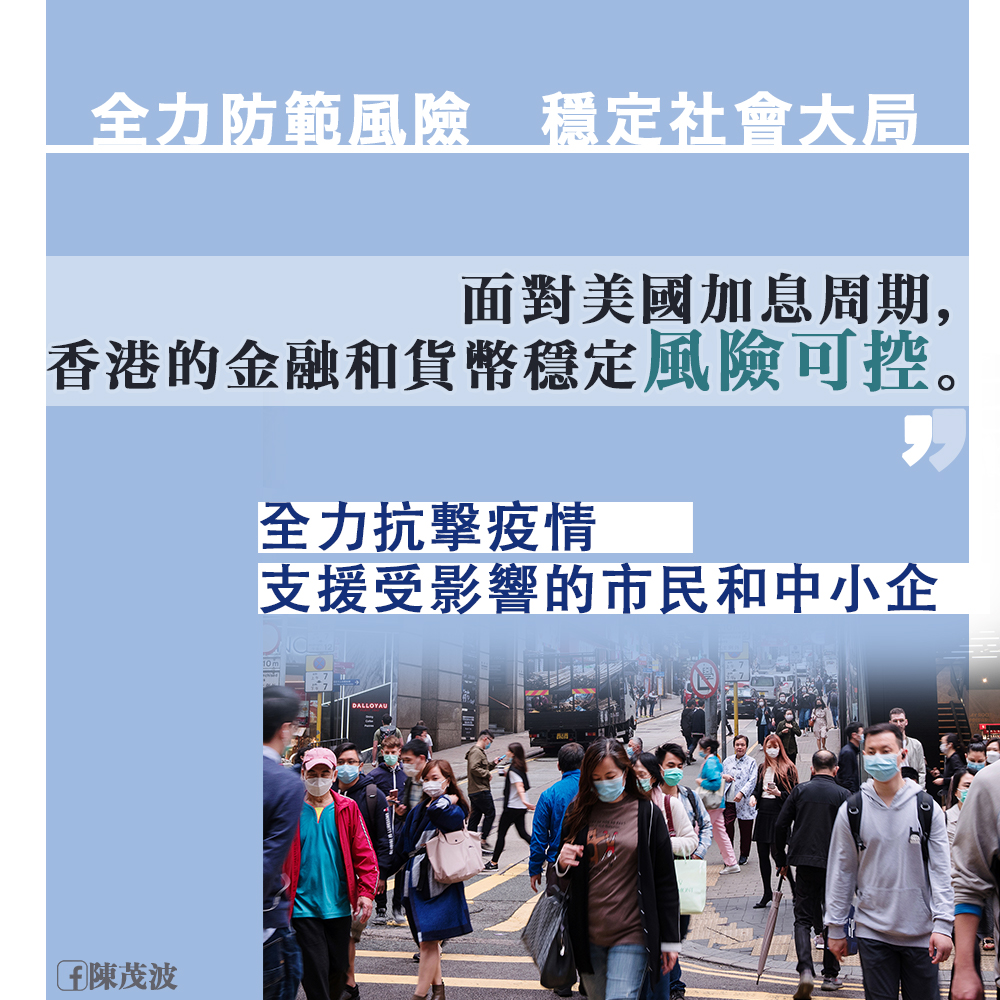Blog
Making best efforts to manage risks and stabilise social situation
The journey in fighting against the virus over the past two years has not been easy. The fifth wave of outbreak since last month has dragged the whole society into a difficult battle. To safeguard people’s safety and health, we have to dedicate our best efforts to fight against the epidemic by adhering to the aim and strategy of dynamic “zero infection”.
In face of the rapid spreading of virus in the community, bottlenecks on various fronts have been seen and additional supports are urgently needed. With the caring support and assistance of the Central Government, we will be better equipped to tackle and solve our imminent difficulties faster and curb the epidemic as soon as possible, which is the key to maintain people’s confidence and support the economy.

|
At this testing time amid the rapidly changing external environment, maintaining economic and financial stability are equally important. We have to be alert of any sudden reversal of capital flow or market sentiment. In particular, US inflation has continued to heat up from 1.4% at the beginning of last year to a significant rise of 7.5% last month, exceeding market expectations and reaching the highest level in 40 years. This also explains why the US Federal Reserve is going to tighten monetary policy at a faster pace than that in the last interest rate hike cycle. This expectation has led to fluctuations in global stock markets last week. Going forward, we must pay attention to the impact brought by changes in interest rates and global capital flows on the asset and foreign exchange markets in the Asia-Pacific region.
As a small and fully open economy, Hong Kong must stay vigilant against such potential risks. We have been closely monitoring the changes in the external environment. Our assessment is that the risks brought by this round of US interest rate hike to Hong Kong's financial and monetary stability are manageable, and the buffers we have built up over the years for the financial market and the related measures put in place have been working effectively.
In terms of capital inflow into Hong Kong dollars, under the Linked Exchange Rate System, the Hong Kong Dollar (HKD) interbank rates usually track their US dollar (USD) counterparts, but they may also be influenced by the level of liquidity in the market. Take the previous US interest rate hike cycle as an example, the US rate had increased by 2.25% cumulatively from 2015 to 2018, while the prime rate in Hong Kong was raised only once ranging between 0.125% to 0.25% in the same period. Currently our banks remained well-capitalised with robust liquidity positions and the aggregate balance has reached HKD350 billion. As such, even if the US raises its interest rate, it is expected that changes in capital inflow will not lead to an increase of Hong Kong interbank rates. Furthermore, Hong Kong’s current account remains strong. Our average current account surplus amounted to 10% of our GDP over the last four quarters, and our foreign exchange reserves has reached the level of USD500 billion, which provide us with strong resilience against the changes in fund flows.
As for the property market, the multiple rounds of macro-prudential measures introduced in the past have resulted in a relatively stable mortgage-to-loan ratio, with the average repayment-to-income ratio of mortgage lenders at a low level of 36%. The stress test conducted by banks in approving loans also takes into account the financial resilience of lenders in the event of interest rate hikes. Hence, we do not see the property market posing systemic risks to the financial system.
The banking system in Hong Kong has always maintained a high degree of resilience to shocks. For example, (1) banks have a strong capital buffer, with an average capital adequacy ratio of 20%, substantially higher than the international minimum standard of 8%; (2) the average liquidity coverage ratio is 150%, which is also much higher than the statutory minimum requirement of 100%; and (3) the bank's asset portfolio remains healthy, with the overall bad debt ratio at 0.81% at the end of September 2021, which is very low when compared to international standards and historical data. Regular stress tests on banks conducted by the Hong Kong Monetary Authority (HKMA) have shown that the banking system can withstand a potential surge in interest rates and its knock-on effects.
However, the potential upward trend in interest rates and the impact of the epidemic on the economy in recent months may affect the cash flow and even repayment ability of some individuals and SMEs. We and the HKMA have been paying close attention to the situation, and further encouraged our banks to provide support and flexibility to enterprises as far as possible in such a hard time. By working together to overcome difficulties, let us strive for a strong post-pandemic recovery for our economy!
February 13, 2022